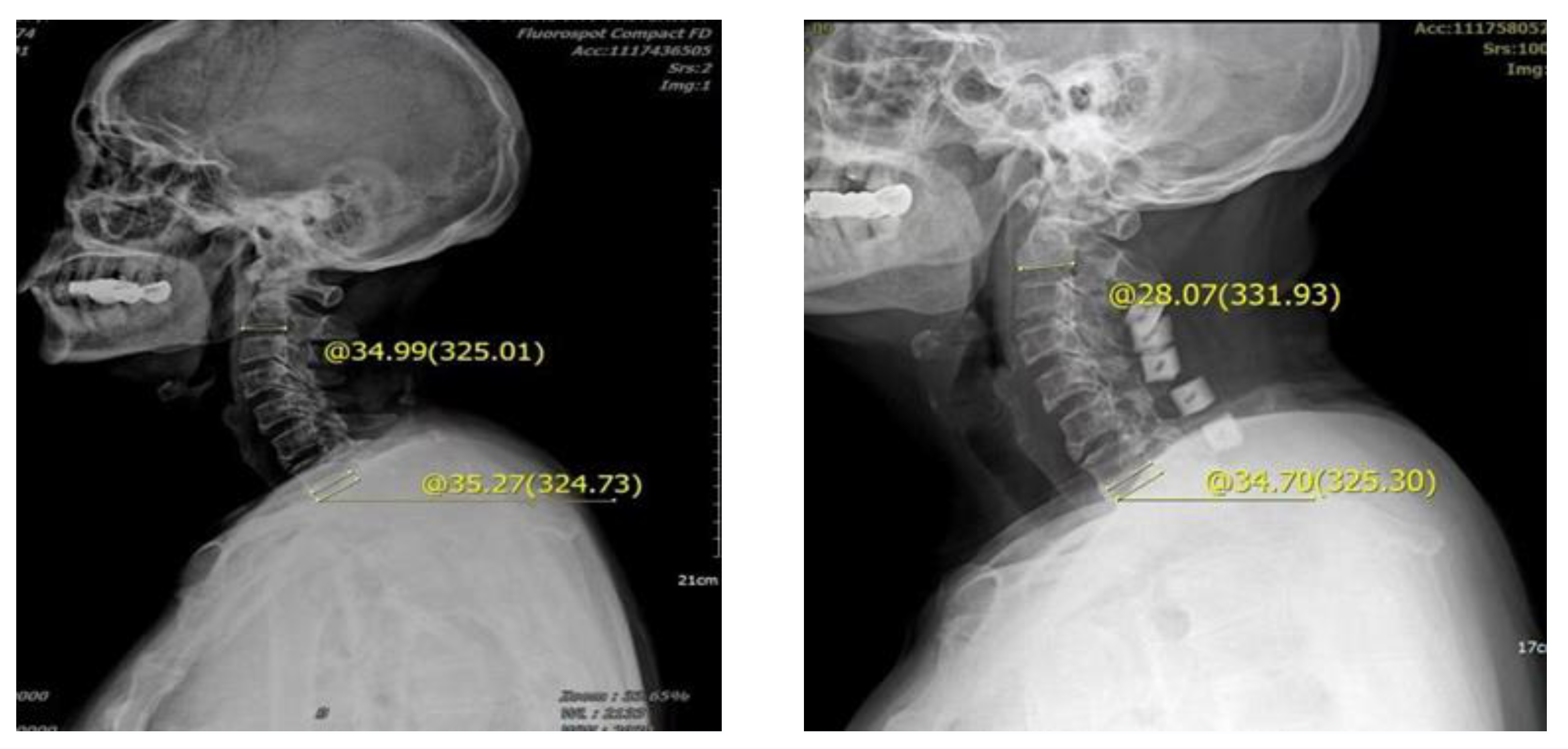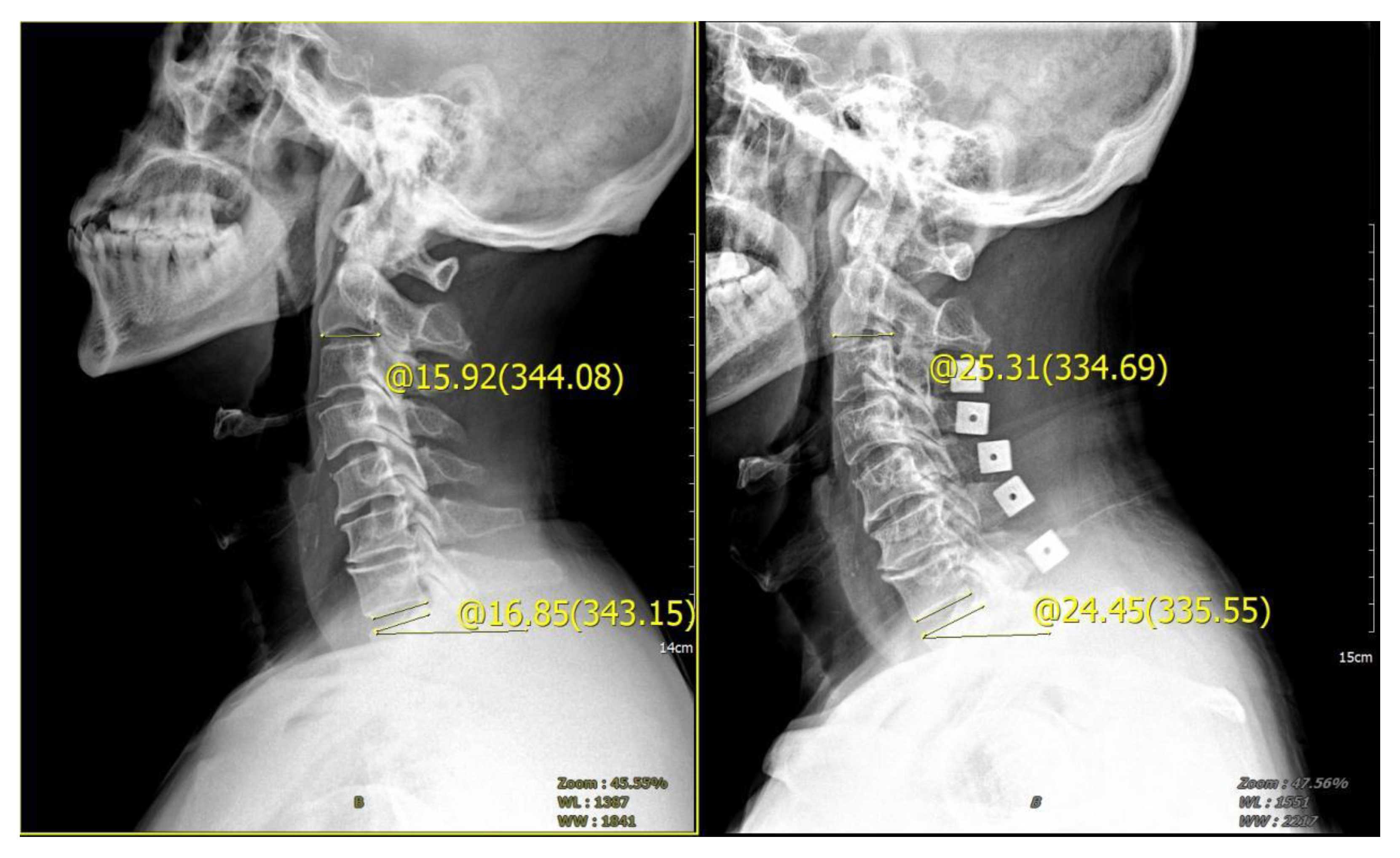Effect of T1 Slope on Disappearance of Cervical Lordosis after Posterior Cervical Double-Door Laminoplasty Based on Medical Informatics
Abstract
:1. Introduction
2. Materials and Methods
2.1. Study Design
2.2. Surgical Procedures
2.3. Measurement Standard
2.4. Statistical Analysis
3. Results
4. Discussion
5. Significance of Maintaining Normal Cervical Curvature
6. Conclusions
Author Contributions
Funding
Institutional Review Board Statement
Informed Consent Statement
Data Availability Statement
Conflicts of Interest
References
- Shimomura, T.; Sumi, M.; Nishida, K.; Maeno, K.; Tadokoro, K.; Miyamoto, H.; Kurosaka, M.; Doita, M. Prognostic factors for deterioration of patients with cervical spondylotic myelopathy after nonsurgical treatment. Spine 2007, 32, 2474–2479. [Google Scholar] [CrossRef]
- Zuo, K.K.; Qin, W.; Miao, Y.; Zhu, L. Analysis of risk factors of axial neck pain in posterior cervical single-door laminoplasty from the perspective of cervical sagittal plane. Front. Surg. 2022, 9, 973924. [Google Scholar] [CrossRef]
- Matz, P.G.; Anderson, P.A.; Holly, L.T.; Groff, M.W.; Heary, R.F.; Kaiser, M.G.; Mummaneni, P.V.; Ryken, T.C.; Choudhri, T.F.; Vresilovic, E.J.; et al. The natural history of cervical spondylotic myelop-athy. J. Neurosurg. Spine 2009, 11, 104–111. [Google Scholar] [CrossRef] [PubMed] [Green Version]
- Oe, S.; Togawa, D.; Nakai, K.; Yamada, T.; Arima, H.; Banno, T.; Yasuda, T.; Kobayasi, S.; Yamato, Y.; Hasegawa, T.; et al. The Influence of Age and Sex on Cervical Spinal Alignment among Volunteers Aged over 50. Spine 2015, 40, 1487–1494. [Google Scholar] [CrossRef] [PubMed]
- Hirabayashi, S.; Kitagawa, T.; Yamamoto, I.; Yamada, K.; Kawano, H. Development and Achievement of Cervical Laminoplasty and Related Studies on Cervical Myelopathy. Spine Surg. Relat. Res. 2020, 4, 8–17. [Google Scholar] [CrossRef] [Green Version]
- Alam, I.; Sharma, R.; Borkar, S.A.; Goda, R.; Katiyar, V.; Kale, S.S. Factors predicting loss of cervical lordosis following cervical lami-noplasty: A critical review. J. Craniovertebral Junction Spine 2020, 11, 163–168. [Google Scholar]
- Machino, M.; Yukawa, Y.; Hida, T.; Ito, K.; Nakashima, H.; Kanbara, S.; Morita, D.; Kato, F. Cervical alignment and range of motion after lamino-plasty: Radiographical data from more than 500 cases with cervical spondylotic myelopathy and a review of the literature. Spine 2012, 37, E1243–E1250. [Google Scholar] [CrossRef] [PubMed]
- Lee, S.-H.; Kim, K.-T.; Seo, E.-M.; Suk, K.-S.; Kwack, Y.-H.; Son, E.-S. The influence of thoracic inlet alignment on the craniocervical sagittal balance in asymptomatic adults. J. Spinal Disord. Tech. 2012, 25, E41–E47. [Google Scholar] [CrossRef]
- Patwardhan, A.G.; Khayatzadeh, S.; Havey, R.M.; Voronov, L.I.; Smith, Z.A.; Kalmanson, O.; Ghanayem, A.J.; Sears, W. Cervical sagittal balance: A biomechanical perspective can help clinical practice. Eur. Spine J. 2018, 27, 25–38. [Google Scholar] [CrossRef]
- Jenkins, L.A.; Capen, D.A.; Zigler, J.E.; Nelson, R.W.; Nagelberg, S. Cervical spine fusions for trauma. A long-term radiographic and clinical evaluation. Orthop. Rev. 1994, 13–19. [Google Scholar]
- Lee, S.H.; Hyun, S.-J.; Jain, A. Cervical Sagittal Alignment: Literature Review and Future Directions. Neurospine 2020, 17, 478–496. [Google Scholar] [CrossRef] [PubMed]
- Lee, S.-H.; Son, E.-S.; Seo, E.-M.; Suk, K.-S.; Kim, K.-T. Factors determining cervical spine sagittal balance in asymptomatic adults: Correlation with spinopelvic balance and thoracic inlet alignment. Spine J. 2015, 15, 705–712. [Google Scholar] [CrossRef] [PubMed]
- Ling, F.P.; Chevillotte, T.; Leglise, A.; Thompson, W.; Bouthors, C.; Le Huec, J.-C. Which parameters are relevant in sagittal balance analysis of the cervical spine? A literature review. Eur. Spine J. 2018, 27, 8–15. [Google Scholar] [CrossRef] [PubMed]
- Liu, C.; Li, Y.; Li, X.; Shi, B.; Lu, S. Factors related to T1 slope: Spinopelvic balance and thoracic compensation. BMC Surg. 2023, 23, 145. [Google Scholar] [CrossRef]
- Ha, Y.; Schwab, F.; Lafage, V.; Mundis, G.; Shaffrey, C.; Smith, J.; Bess, S.; Ames, C. Reciprocal changes in cervical spine alignment after corrective thoracolumbar deformity surgery. Eur. Spine J. 2014, 23, 552–559. [Google Scholar] [CrossRef] [Green Version]
- van Geest, S.; de Vormer, A.M.J.; Arts, M.P.; Peul, W.C.; Vleggeert-Lankamp, C.L.A. Long-term follow-up of clinical and radiological outcome after cervical laminectomy. Eur. Spine J. 2015, 24 (Suppl. S2), 229–235. [Google Scholar] [CrossRef]
- Kawakami, M.; Tamaki, T.; Yoshida, M.; Hayashi, N.; Ando, M.; Yamada, H. Axial symptoms and cervical alignments after cervical anterior spinal fusion for patients with cervical myelopathy. J. Spinal Disord. 1999, 12, 50–56. [Google Scholar] [CrossRef]
- He, W.; He, D.; Wang, Q.; Tian, W.; Liu, B.; Liu, Y.; Sun, Y.; Xing, Y.; Yuan, N.; Yuan, Q.; et al. Longitudinal Spinous-Splitting Laminoplasty with Coral Bone for the Treatment of Cervical Adjacent Segment Degenerative Disease: A 5-Year Follow-up Study. Orthop. Surg. 2021, 14, 435–442. [Google Scholar] [CrossRef]
- Wang, S.-J.; Jiang, S.-D.; Jiang, L.-S.; Dai, L.-Y. Axial pain after posterior cervical spine surgery: A systematic review. Eur. Spine J. 2011, 20, 185–194. [Google Scholar] [CrossRef] [Green Version]
- Capen, D.A.; Garland, D.E.; Waters, R.L. Surgical stabilization of the cervical spine. A comparative analysis of anterior and posterior spine fusions. Clin. Orthop. Relat. Res. 1985, 196, 229–237. [Google Scholar] [CrossRef]
- Cheung, J.P.Y.; Luk, K.D.-K. Complications of Anterior and Posterior Cervical Spine Surgery. Asian Spine J. 2016, 10, 385–400. [Google Scholar] [CrossRef] [PubMed]
- Rajshekhar, V.; Arunkumar, M.J.; Kumar, S.S. Changes in cervical spine curvature after uninstrumented one- and two-level corpectomy in patients with spondylotic myelopathy. Neurosurgery 2003, 52, 799–805. [Google Scholar] [CrossRef] [PubMed]
- Riew, K.; Raich, A.; Dettori, J.; Heller, J. Neck Pain Following Cervical Laminoplasty: Does Preservation of the C2 Muscle Attach-ments and/or C7 Matter? Evid. Based Spine Care J. 2013, 4, 42–53. [Google Scholar]
- Takeuchi, K.; Yokoyama, T.; Aburakawa, S.; Saito, A.; Numasawa, T.; Iwasaki, T.; Itabashi, T.; Okada, A.; Ito, J.; Ueyama, K.; et al. Axial symptoms after cervical laminoplasty with C3 laminectomy compared with conventional C3-C7 laminoplasty: A modified laminoplasty preserving the semispinalis cervicis inserted into axis. Spine 2005, 30, 2544–2549. [Google Scholar] [CrossRef]
- Yonenobu, K.; Hosono, N.; Iwasaki, M.; Asano, M.; Ono, K. Laminoplasty versus subtotal corpectomy. A comparative study of results in multisegmental cervical spondylotic myelopathy. Spine 1992, 17, 1281–1284. [Google Scholar] [CrossRef]
- Kim, P.; Murata, H.; Kurokawa, R.; Takaishi, Y.; Asakuno, K.; Kawamoto, T. Myoarchitectonic spinolaminoplasty: Efficacy in reconstituting the cervical musculature and preserving biomechanical function. J. Neurosurg. Spine 2007, 7, 293–304. [Google Scholar] [CrossRef]
- Miyazaki, M.; Hymanson, H.J.; Morishita, Y.; He, W.; Zhang, H.; Wu, G.; Kong, M.H.; Tsumura, H.; Wang, J.C. Kinematic analysis of the relationship between sagittal alignment and disc degeneration in the cervical spine. Spine 2008, 33, E870–E876. [Google Scholar] [CrossRef]
- Knott, P.T.; Mardjetko, S.M.; Techy, F. The use of the T1 sagittal angle in predicting overall sagittal balance of the spine. Spine J. 2010, 10, 994–998. [Google Scholar] [CrossRef]
- Pal, G.P.; Sherk, H.H. The vertical stability of the cervical spine. Spine 1988, 13, 447–449. [Google Scholar] [CrossRef]
- Takeshita, K.; Peterson, E.T.; Bylski-Austrow, D.; Crawford, A.H.; Nakamura, K. The nuchal ligament restrains cervical spine flexion. Spine 2004, 29, E388–E393. [Google Scholar] [CrossRef]
- Jeong, G.K.; Bendo, J.A. Spinal disorders in the elderly. Clin. Orthop. Relat. Res. 2004, 425, 110–125. [Google Scholar] [CrossRef] [PubMed]
- Maeda, T.; Arizono, T.; Saito, T.; Iwamoto, Y. Cervical alignment, range of motion, and instability after cervical laminoplasty. Clin. Orthop. Relat. Res. 2002, 401, 132–138. [Google Scholar] [CrossRef]
- Nolan, J.P.; Sherk, H.H. Biomechanical evaluation of the extensor musculature of the cervical spine. Spine 1988, 13, 9–11. [Google Scholar] [CrossRef] [PubMed]
- Ogino, H.; Tada, K.; Okada, K.; Yonenobu, K.; Yamamoto, T.; Ono, K.; Namiki, H. Canal diameter, anteroposterior compression ratio, and spondylotic myelopathy of the cervical spine. Spine 1983, 8, 1–15. [Google Scholar] [CrossRef] [PubMed]
- Iizuka, H.; Nakajima, T.; Iizuka, Y.; Sorimachi, Y.; Ara, T.; Nishinome, M.; Takagishi, K. Cervical malalignment after laminoplasty: Relationship to deep extensor musculature of the cervical spine and neurological outcome. J. Neurosurg. Spine 2007, 7, 610–614. [Google Scholar] [CrossRef]





| Curvature Loss | Case | Gender: M/F | T1s Preoperative |
|---|---|---|---|
| Curvature loss | 20 | 14/6 | 23.94 |
| Curvature no loss | 20 | 16/4 | 23.15 |
| Group | Case | Average T1s (°) | Preoperative Cobb Angle of Cervical Spine (°) | Postoperative Cobb Angle of Cervical Spine (°) | Loss of Curvature (°) | Preoperative NDI | Postoperative NDI | Preoperative VAS | Postoperative VAS | VAS Improvement |
|---|---|---|---|---|---|---|---|---|---|---|
| Group A (T1s > 23.54°) | 22 | 30.26 ± 9.95 | 10.84 ± 8.11 | 9.14 ± 5.33 | 1.71 ± 3.17 | 32.4 ± 3.4 | 16.5 ± 2.1 | 5.41 ± 1.1 | 5.55 ± 0.3 | −0.2% |
| Group B (T1s < 23.54°) | 18 | 15.34 ± 7.23 | 5.65 ± 5.09 | 8.23 ± 5.01 | 2.58 ± 3.11 | 30.1 ± 2.9 | 11.5 ± 3.1 | 5.11 ± 1.2 | 4.18 ± 0.7 | 18% |
Disclaimer/Publisher’s Note: The statements, opinions and data contained in all publications are solely those of the individual author(s) and contributor(s) and not of MDPI and/or the editor(s). MDPI and/or the editor(s) disclaim responsibility for any injury to people or property resulting from any ideas, methods, instructions or products referred to in the content. |
© 2023 by the authors. Licensee MDPI, Basel, Switzerland. This article is an open access article distributed under the terms and conditions of the Creative Commons Attribution (CC BY) license (https://creativecommons.org/licenses/by/4.0/).
Share and Cite
Zhao, Y.; Zhang, B.; Yuan, B. Effect of T1 Slope on Disappearance of Cervical Lordosis after Posterior Cervical Double-Door Laminoplasty Based on Medical Informatics. Brain Sci. 2023, 13, 1189. https://doi.org/10.3390/brainsci13081189
Zhao Y, Zhang B, Yuan B. Effect of T1 Slope on Disappearance of Cervical Lordosis after Posterior Cervical Double-Door Laminoplasty Based on Medical Informatics. Brain Sciences. 2023; 13(8):1189. https://doi.org/10.3390/brainsci13081189
Chicago/Turabian StyleZhao, Yulin, Binglei Zhang, and Baisheng Yuan. 2023. "Effect of T1 Slope on Disappearance of Cervical Lordosis after Posterior Cervical Double-Door Laminoplasty Based on Medical Informatics" Brain Sciences 13, no. 8: 1189. https://doi.org/10.3390/brainsci13081189
APA StyleZhao, Y., Zhang, B., & Yuan, B. (2023). Effect of T1 Slope on Disappearance of Cervical Lordosis after Posterior Cervical Double-Door Laminoplasty Based on Medical Informatics. Brain Sciences, 13(8), 1189. https://doi.org/10.3390/brainsci13081189






